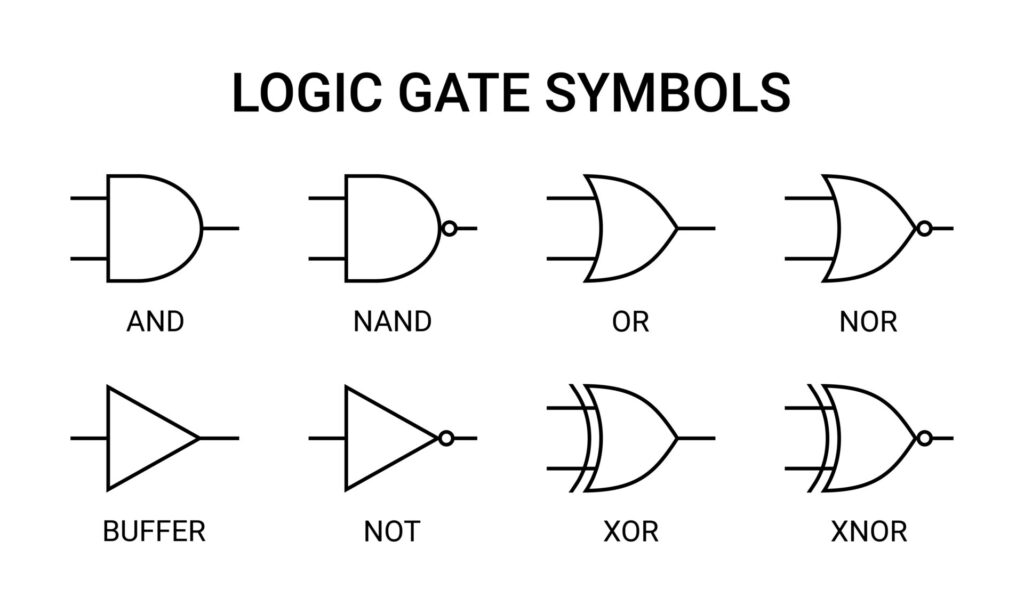Elevate your design and manufacturing processes with Autodesk Fusion
Ever wonder what’s going on behind the scenes of our most amazing electronic inventions? Learn about the hidden world of digital electronics and logic gates.
Understanding logic gates: the hidden world of digital electronics

The binary world of 1s and 0s alone doesn’t allow us to re-land rockets in the middle of the ocean, deliver packages within minutes through the use of drones, or map the known physical universe and all of its wonders. No, what makes all of this possible is our ability to slice and dice binary numbers in all of their infinite possibilities through some heavy-hitting mathematics. Our ability to add, subtract, multiply, and divide binary numbers in a variety of ways is what has allowed us to create the world of digital electronics that we know today. To get from 1s and 0s to the latest advances in medicine, space exploration, and science, you’ve got to start with logic gates.
Out on the farm
Let’s say you’re living out on a farm, and you’ve got a bunch of chickens to tend to on a nice plot of land. Each morning you wake up, open the gate to your farm, and let your chickens loose out in your pasture. This gate is your method of controlling the flow of chickens into and out of your farm and helps you to meet your goals of having happy and healthy creatures that continue laying eggs for years on end.

In a computer, we can also use a gate to control a flow and achieve an end goal, but instead of chickens, we control the flow of an electric current as it goes running around a circuit. This gate in the world of digital electronics is known as a transistor and can be in one of two states, on or off, or open or closed if you like to think of it as a gate. When a transistor is on, or open, then an electric current can flow through. And when it’s off, then no current flows.
When you string a bunch of these transistors together, then you get what’s called a logic gate, which lets you add, subtract, multiply, and divide binary numbers in any way imaginable. In a physical circuit, these logic gates have:
- Inputs: All logic gates require some kind of input value so that they have numbers to compare. These figures come in the form of voltages. When your input voltage is 0V, then it’s considered to be low, or 0. And when you have a voltage of 5V as an input, then this is deemed to be high, or 1.
- Outputs: Once a logic gate has a chance to process your input, it can then make a decision on whether to open its gate or keep it closed. This output is entirely determined by the type of logic gate you’re using, and some will only open if you have two high voltages as an input, whereas others will only open if you have a low voltage but not a high voltage as an input.
By using a combination of both high and low voltages and sending them through a logic gate’s input, we can make some amazing things happen. But at the end of the day, we’re still working with a fundamental question: do we want to allow a particular logic gate to allow an electric current to pass through, or not? While this might seem simplistic at an individual level, chaining all of this logic and decision-making together is how we’ve gone to create some amazing digital electronics in such a short period of history. But are logic gates really anything new?
The concepts are older than you think

Logic gates have been around for longer than you’ve been alive, in varying forms of computer technologies. What started as mechanical relay switches consisting of an electromagnetic and a set of contacts soon evolved into vacuum tubes for use in televisions, light bulbs, and more in the 1900s. And while these vacuum tubes were a lot faster than their relay counterparts, they were just as bulky and unreliable, which led us to the creation of the transistor in 1947.
Transistors were perfect. They were reliable, didn’t consume nearly as much power as vacuum tubes and relays, and were incredibly small in size. Despite their difference in size and shape, the function of relays, vacuum tubes, and transistors were all the same. They worked as a switch to control the flow of electricity based on some input voltage.
In the 1960s, we started to put together a collection of transistors together that led to the creation of the first integrated circuit, ushering in our age of modern computers. These ICs started off simple, cramming in about 20 transistors in a 3 mm square chip of silicon with other components like resistors and diodes. The earliest ICs were referred to as small-scale integrated (SSI) ICs.

The production of ICs continued to advance though, soon cramming in 4,800 transistors in the first microprocessor in 1974 made by Intel. Today, we’re in the age of very large-scale integrated (VLSI) ICs, which can pack in millions and even billions of transistors into one tiny package. All of these integrated circuits are mathematical powerhouses, stringing together a dizzying amount of logic gates with the help of transistors to add, subtract, multiply, and divide numbers as we please.
Logic gates and chickens
There are a variety of logic gates, including AND, OR, NOT, XOR, NAND, and NOR. Each of these logic gates has a very specific way of handling the inputs and the output that it produces. But regardless of what kind of logic gate we’re talking about, the inputs and outputs will break everything down to two binary numbers that make up digital electronics, 1 and 0.

AND gate

Let’s head back to our farm for a minute. Say we want to let out one of our chickens, but only if it’s with a rooster so that it can have some protection out on our pasture. In this case, our chicken and rooster are dependent on each other. If the chicken AND the rooster are together, then we can let them through our gate and out into the pasture.
This is how an AND gate works in an electronic circuit. The only way to get a high output of 1 is to have both of your inputs be 1s as well. Let’s break this down and see how it works using our chickens in three scenarios:
- If we have a chicken AND a rooster at our gate, then we will open the gate.
- If we have a chicken AND no rooster at our gate, then we will keep the gate closed.
- And if we have no chicken AND no rooster at our gate, then we will keep the gate closed.
See the pattern here? Both inputs of an AND gate are entirely dependent on each other. You can’t have one without the other to produce an output of 1. The only way to get a 1 for output is to have two of the same inputs flowing in. Otherwise, the gate in a transistor remains closed, and no electricity will be able to flow through. Here’s how an AND gate will look on a schematic.
OR gate

Back on our farm again, let’s say this time we put up a fence, so we aren’t too worried about our chickens going out with a rooster for protection. In this example, our chicken and rooster are not dependent on each other, so if a chicken OR a rooster approaches our gate, we will open it for them.
With an OR gate, you only need one of your inputs to be a 1 for the output to also be a 1. Here’s how it would break down in our chicken scenario:
- If we have a chicken OR a rooster at our gate, then we will open the gate.
- If we have a chicken OR no rooster at our gate, then we will open the gate.
- If we have no chicken OR no rooster at our gate, then we will keep the gate closed.
The pattern here is also pretty clear as well. Both of our inputs are not dependent on each other, and so long as one of them is present, our gate will open. Here’s how all of this will look in a truth table with A and B being inputs, and Q being the output:
If you want to quickly identify an OR gate on a schematic, look for this symbol:
NOT gate

The NOT gate gets a little tricky with our chicken analogy, so let’s try something else. Say you also have some goats on your farm, but you don’t ever want to let them outside of your gate. So even if we have a goat at our NOT gate really wanting to go out, we aren’t going to open the gate. Despite our goat representing a 1 in our logic gate as an input, a NOT gate always produces an opposite output.
But let’s say the goat walks away from our gate, we now have a 0 as our input, being the absence of the goat. According to our NOT gate, this will produce an output of a 1, meaning that we can keep our gate open so long as we don’t have any goats nearby.
NOT gates are a bit strange when compared to other gates, as they always do the complete opposite of whatever input value you provide it. These gates also only require one input to produce their output, whereas other gates will always need two inputs. Here’s how the combinations for a NOT gate will look in a truth table with A being the sole input and Q being the output:
And it’s pretty easy to spot a NOT gate on a schematic, just look for the logic gate with only one input and one output.
XOR Gate

Back to our farm, we have an XOR gate, which is just like an OR gate, except that if both of our inputs are present, then the gate will remain closed. You can think of an XOR gate as being a kind of either/or situation. For example:
- If we have EITHER a chicken OR a rooster at our gate, then we will open the gate.
- If we have no chicken or rooster at our gate, then we will keep the gate closed.
- If we have both a chicken and a rooster at our gate, then we will keep the gate closed.
Another way of understanding an XOR gate is this – you’ll always get an output of 1 if your inputs are a mix of a 1 and a 0. And if you have two of the same inputs, like a 0 and a 0, or a 1 and a 1, then you’ll get a 0 for an output. Here’s how all of the XOR gate combinations will look in a truth table with A and B being inputs, and Q being the output:
And to put an XOR gate on a schematic, be on the lookout for this symbol:
XNOR Gate

This gate is a combination of the XOR and NOT gates. So the outputs will be 1 if the inputs are the same, regardless of whether they’re 1s or 0s. And if the inputs are different, the output will be 0, or false. For our chickens, we can use an XNOR gate to open our gate only when a chicken and rooster pair journey out together, or if there are no chickens or roosters together. For example:
- If we have a chicken OR a rooster at our gate, then we will open the gate.
- If we have a chicken but not a rooster at our gate, then we will keep the gate closed.
- If we have no chicken OR rooster at our gate, then we will open the gate.
And here’s how all of this will break down in a truth table, with A and B being the inputs, and Q being the output:
The schematic symbol for an XNOR gate looks very similar to an XOR gate with the addition of a dot at the end of the output:
NAND Gate

This gate works similarly to an AND gate, except that when you have two inputs of 1, you’ll always get an output of 0. So let’s say that we only want to let our chickens out one at a time, but not with a rooster. A NAND gate is just what we need to make this happen:
- If we have both a chicken AND a rooster at our gate, then we will NOT open the gate.
- If we have a chicken AND no rooster at our gate, then we will open the gate.
- If we have no chicken AND no rooster at our gate, then we will open the gate.
If you’re getting stuck on this then, then try thinking of it like this – a NAND gate works as both an AND gate and a NOT gate. It first compares the two values using AND logic and then provides an opposite output based on the AND logic. Here’s how all of this breaks down in a truth table with A and B being inputs, and Q being the output:
NOR Gate

Our last and final gate to work with on our farm is a NOR gate, which is just like a NAND gate in that it has an opposite output than you might expect. A NOR gate will work just like an OR gate, except that its output is opposite of an OR gate’s output. For example, back on our farm let’s say we have a mean storm raging outside and we don’t want to let any of our chickens into our pasture. The NOR gate is just what we need:
- If we have a chicken OR a rooster at our gate, then we will not open the gate.
- If we have a chicken OR no rooster at our gate, then we will not open the gate.
- If all of our chickens are safe in their coop and not at our gate, then we will open the gate.
Still with us? A NOR gate works both as an OR gate and a NOT gate. It first compared the two values using OR logic and then provides an opposite output based on the OR logic.
They’re Super Calculators

While individual logic gates on their surface are all relatively simple and straightforward, it’s the combination of these gates together that really brings out their superpowers. By using a combination of logic gates together in an integrated circuit, you can perform some incredibly complex calculations. And the more logic gates that you pack into the same physical space, the faster you can calculate!
Wherever you look in the world of digital electronics, you’ve got logic gates at play, doing all of the heavy mathematical lifting to make some amazing things happen. So the next time you hear some beautiful music pouring out of your speakers, or you watch a SpaceX rocket landing in the middle of an ocean without a second thought, remember that you’ve got logic gates to thank, working tirelessly behind the scenes.
Ready to experiment with your very own logic gates? Try Autodesk Fusion 360 for free!